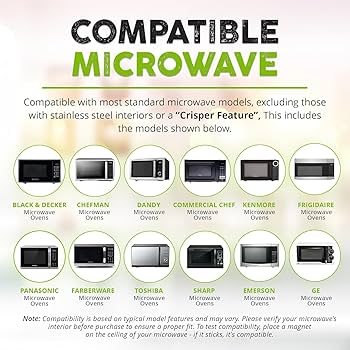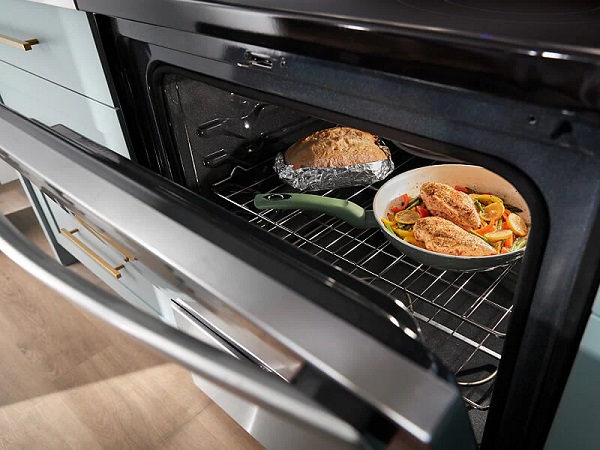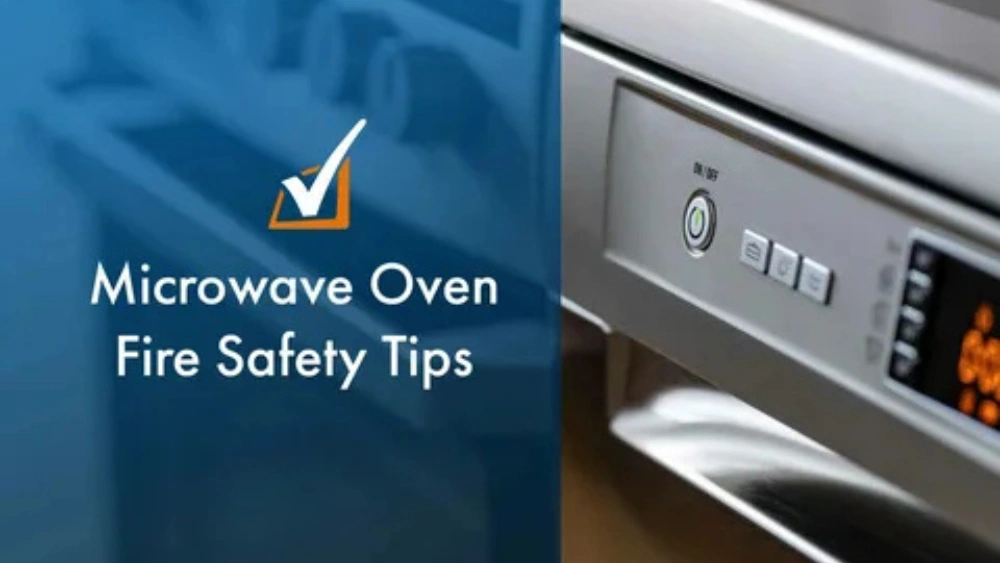Have you ever wondered what those tiny symbols on your plates really mean? When you heat food in your microwave or oven, using the right dishes isn’t just about convenience—it’s about your safety.
Understanding plate labels can save you from accidents, ruined meals, and costly damages. You’ll discover exactly how to read these labels and why they matter every time you cook or reheat. Keep reading to make your kitchen safer and your cooking smoother.

Credit: www.amazon.com
Microwave Safe Labels
Microwave safe labels help you know if a plate can go in the microwave without damage. These labels prevent accidents and keep your dishes safe. Understanding these labels saves time and avoids messes.
Common Symbols On Plates
- A microwave symbol means the dish is safe for microwave use.
- Wavy lines often indicate microwave safety.
- A crossed-out microwave icon means the plate is not microwave safe.
- Sometimes text like “Microwave Safe” is printed on the plate.
- Look for numbers or codes that show heat resistance.
Materials That Are Microwave Safe
- Ceramic and stoneware usually handle microwave heat well.
- Glass plates made for cooking are safe in microwaves.
- Some plastics marked microwave safe can be used.
- Avoid metal, as it causes sparks in microwaves.
- Paper plates designed for microwave use are generally safe.
How To Identify Microwave Safe Dishes
Check the bottom or back of the plate for labels or symbols. Read the packaging if you just bought the item. Test plates by heating with water inside for short times. If the plate gets very hot, it is unsafe. Use only dishes marked safe for microwave use to avoid damage.
Oven Safe Labels
Oven safe labels are crucial for anyone who uses cookware or dishes in an oven. These labels tell you if a plate or dish can handle the high temperatures without cracking or releasing harmful substances. Ignoring these labels can lead to damaged cookware or even safety hazards in your kitchen.
Symbols Indicating Oven Safety
Look closely at your cookware for specific symbols that show if it’s oven safe. Common icons include a small oven illustration or a temperature number with a degree symbol. Sometimes you’ll find words like “Oven Safe”or temperature limits printed clearly.
Have you ever wondered why some plates break in the oven while others don’t? That’s because only those with the right symbols are designed to withstand oven heat. Without these symbols, it’s risky to put your dish in the oven.
Heat-resistant Materials
Materials like tempered glass, ceramic, and certain metals usually have oven safe labels. These materials can handle heat without warping or shattering. Plastic or melamine plates rarely carry oven safe labels because they melt or release toxins under high heat.
Think about your own dishes. Are they made from materials that can take the oven’s heat? If not, you might want to switch to safer options to avoid accidents.
Checking Temperature Limits
Oven safe labels sometimes include maximum temperature limits. This tells you the highest heat your plate can safely endure. Ignoring this limit can cause sudden breakage or damage to your cookware.
Always check these temperature limits before using a plate in the oven. It’s better to be cautious and prevent costly replacements or kitchen mishaps. Have you checked the temperature limits on your dishes lately?
Avoiding Unsafe Materials
Knowing which materials are safe for your microwave and oven can protect your kitchen and your health. Not all plates and containers are built to handle heat the same way. Understanding the labels and avoiding unsafe materials can save you from accidents and ruined meals.
Plastics To Avoid In Microwave
Some plastics release harmful chemicals when heated. Avoid containers that don’t say “microwave-safe” or have recycling codes 3, 6, or 7. These may contain BPA or other toxins that can leach into your food.
Even if a plastic container looks sturdy, it might warp or melt under microwave heat. Always check for a microwave-safe label before using it. Your health and your microwave’s lifespan depend on this simple check.
Non-oven Safe Ceramics And Glass
Ceramics and glass that aren’t labeled oven-safe can crack or shatter from temperature changes. Some decorative plates with metallic paint are especially risky. Using these in the microwave or oven can cause dangerous sparks or breakage.
Have you ever placed a favorite mug in the microwave only to find it cracked afterward? That’s a clear sign it wasn’t oven-safe. Stick to items clearly marked as microwave or oven-safe to avoid surprises.
Metal And Foil Restrictions
Metal objects and aluminum foil are generally off-limits in microwaves. They reflect microwaves, causing sparks and fires. However, small amounts of foil can sometimes be used in conventional ovens to cover food, but it should never touch oven walls or heating elements.
Have you tried reheating food in a metal container? The spark show is not worth the risk. Always transfer food to microwave-safe dishes to keep your kitchen safe and your meals tasty.

Credit: www.sumkoka.com
Combining Microwave And Oven Use
Combining microwave and oven use can save time and energy in meal preparation. Some plates and dishes are designed for both appliances. Knowing which ones are safe helps avoid accidents and damage.
Dual-safe Plates
Dual-safe plates work in both microwave and oven. They have special labels or symbols indicating this. These plates resist high heat and microwaves without cracking or melting. Using dual-safe plates means fewer dishes to wash and less clutter.
Transitioning From Microwave To Oven
Switching food from microwave to oven requires care. Plates must be cool enough to handle. Sudden temperature changes can cause cracks or breaks. Always check if the plate label allows this transition. Heat the food evenly to avoid hot spots or burns.
Safety Tips For Multi-use Dishes
- Read plate labels clearly before use.
- Avoid metal trims or decorations on plates.
- Let plates cool before moving between appliances.
- Use oven mitts to handle hot dishes.
- Do not exceed recommended temperature limits.
- Check plates regularly for chips or cracks.
Reading Manufacturer Instructions
Understanding plate labels ensures microwave and oven safety. Manufacturer instructions reveal which plates can handle heat. Proper usage prevents damage and accidents.
Reading manufacturer instructions is crucial for microwave and oven safety. Understanding these guidelines ensures proper use of kitchen appliances. They provide essential details about material compatibility and heat limits.
Labeling Variations
Plate labels can vary significantly. Some plates are marked “microwave safe,” while others display temperature limits. The symbols and terms used may differ by brand. Always check the label for specific instructions. Never assume all plates are suitable for high heat.
When In Doubt, Check The Manual
Manuals offer detailed usage instructions for kitchen appliances. They explain what materials are safe to use. Manuals are your go-to source when uncertain about plate safety. They contain valuable information that the label might not cover. Keep your manual accessible for quick reference.
Contacting Manufacturers For Clarifications
Manufacturers can help clarify any confusion. If labels or manuals are unclear, contact them directly. They provide expert advice tailored to their products. Reach out via email or phone for prompt answers. This ensures you use your kitchen appliances safely and effectively.
Credit: www.tiktok.com
Common Mistakes And Risks
Using the wrong plates in microwaves and ovens can cause serious problems. Many people overlook plate labels and face risks like damage and health hazards. Understanding common mistakes helps prevent accidents and keeps your kitchen safe.
Overheating And Cracking
Not all plates handle heat well. Some materials crack or break under high temperatures. Overheating happens when plates are not microwave or oven safe. Cracks can cause sharp edges and ruin your dish. Always check labels for heat resistance.
Toxic Fumes From Unsafe Materials
Plates made from unsafe materials can release harmful fumes when heated. Plastic plates not marked microwave-safe may melt or emit toxins. These fumes can contaminate food and harm your health. Use only plates labeled safe for microwaving or baking.
Fire Hazards
Certain plates can cause fires in ovens and microwaves. Metal trims or decorations can spark and ignite. Overheated plastic plates may catch fire. Ignoring plate labels increases fire risks. Choose plates designed for your cooking appliance to avoid danger.
Tips For Safe Plate Use
Using plates safely in microwaves and ovens protects both your dishes and your health. Following simple tips can prevent accidents and damage. Understanding plate labels helps you choose the right dishes for heating food.
Testing Plates Safely
Test plates before using them in microwaves or ovens. Place the plate alone in the microwave for 20 seconds. If it gets very hot, it is not microwave-safe. Avoid plates with metallic paint or decorations. These can cause sparks and damage.
Proper Cleaning And Maintenance
Clean plates gently to avoid scratches and cracks. Use mild soap and a soft sponge. Avoid harsh abrasives that damage surface coatings. Check plates regularly for signs of wear. Keep plates dry before heating to prevent steam damage.
Replacing Damaged Plates
Replace plates with visible cracks or chips. Damaged plates can break during heating and cause injuries. Do not use plates with fading or peeling labels. These may no longer be safe for microwave or oven use. Choose replacement plates with clear safety labels.
Frequently Asked Questions
What Do Microwave-safe Labels On Plates Mean?
Microwave-safe labels indicate that a plate can withstand microwave heat without damage. These plates won’t melt, crack, or release harmful chemicals during heating.
Can All Oven-safe Plates Be Used In Microwaves?
Not always. Oven-safe plates tolerate high temperatures but may not be microwave-safe. Check labels to ensure suitability for microwave use.
How To Identify Dishwasher And Microwave-safe Labels?
Look for symbols like wavy lines for microwave-safe and water droplets or plates for dishwasher-safe. These icons guide proper usage.
Why Avoid Using Metal Plates In Microwaves?
Metal reflects microwaves, causing sparks and potential fires. Metal plates are unsafe for microwave use and can damage the appliance.
Conclusion
Understanding plate labels helps keep you safe while using microwaves and ovens. Check labels before heating food to avoid damage or injury. Not all plates are microwave or oven safe. Using the wrong plate can cause cracks or dangerous sparks.
Always choose plates marked for your appliance. This small step protects your dishes and your kitchen. Stay cautious and enjoy cooking with confidence. Safety starts with simple label checks every time.

